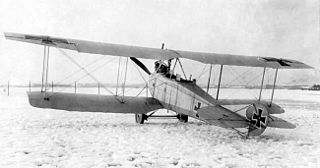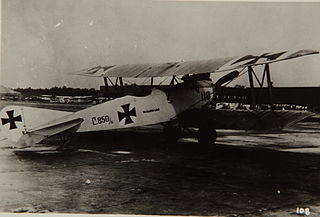| Germania C.I | |
|---|---|
 | |
| Role | Reconnaissance aircraft |
| Manufacturer | Germania Flugzeugwerke |
| First flight | 1917 |
| Primary user | Luftstreitkräfte |
The Germania C.I was a two-seat general-purpose biplane built by Germania Flugzeugwerke during World War I.
| Germania C.I | |
|---|---|
 | |
| Role | Reconnaissance aircraft |
| Manufacturer | Germania Flugzeugwerke |
| First flight | 1917 |
| Primary user | Luftstreitkräfte |
The Germania C.I was a two-seat general-purpose biplane built by Germania Flugzeugwerke during World War I.
Germania Flugzeugwerke built the C.I as a biplane of wooden construction with plywood and fabric construction. A forward firing Spandau machine gun and Parabellum machine gun were mounted in the aft cockpit.
A derivative of the C.I, the C.II, of which only a prototype was built, differed from the C.I in having staggered mainplanes and a reduced gap.[ citation needed ]
Data from [1]
General characteristics
Performance
Armament
Related development
Aircraft of comparable role, configuration, and era
Related lists

The Albatros C.III was a twin-seat general-purpose biplane designed and produced by the German aircraft manufacturer Albatros Flugzeugwerke. It was produced in greater numbers than any other C-type aircraft by Albatros as well as being the company's most-produced twin-seat aircraft.

The Albatros C.I,, was a twin-seat general-purpose biplanes designed and produced by the German aircraft manufacturer Albatros Flugzeugwerke. It was the first of the successful C-series aircraft operated by the Luftstreitkräfte.

The Aviatik C.I was an observation aircraft which came into service during World War I in April 1915. It was a development of the Aviatik B.I and B.II models, being one of first aircraft of the new German C class of armed biplanes. In the C.I the observer sat in front of the pilot, with a machine-gun clipped on a sliding mounting fitted on a rail at either side of the cockpit. It gave the crew the means to attack enemy aircraft. The positions of the pilot and observer were reversed in last series of 50, ordered in 1917 solely for trainer purpose. There was only one aircraft built of refined C.Ia version in May 1916, with armament still in a forward cab, serving as a prototype for C.III. Later models of the plane included the Aviatik C.II and the C.III, which had more powerful engines. The C.III was produced in large numbers.

The Halberstadt C.V was a German single-engined reconnaissance biplane of World War I, built by Halberstädter Flugzeugwerke. Derived from the Halberstadt C.III, with a more powerful supercharged 160 kW (220 hp) Benz Bz.IVü engine, it saw service only in the final months of the war. Cameras were mounted in the observer's cockpit floor.

Entering service in 1915, the Rumpler C.I,, two-seater single-engine reconnaissance biplane, was one of the first German C-type aircraft, and also one of the longest serving in its class during World War I, being retired from the last front line units only in early 1918.

The Hannover CL.II was an escort fighter, produced in Germany during World War I, designed in response to a 1917 requirement by the Idflieg for such a machine to protect reconnaissance aircraft over enemy territory.

The LFG Roland D.II was a German single-seat fighter of World War I. The type was manufactured by Luftfahrzeug Gesellschaft, and also by Pfalz Flugzeugwerke under license.

The LVG C.II was a 1910s German two-seat reconnaissance biplane designed at the Luft-Verkehrs-Gesellschaft for the Luftstreitkräfte.

The Albatros C.II was a 1910s German military pusher reconnaissance biplane designed and built by Albatros Flugzeugwerke. Only one aircraft was built and the type did not enter production.

The Albatros C.IV,. was a German military reconnaissance aircraft built in the autumn of 1915 by Albatros Flugzeugwerke. It was a single-engined biplane, and was based on the Albatros C.III, with which it shared many parts. It was eventually abandoned, in favour of the C.V.

The Halberstadt G.I was a German prototype heavy bomber built by Halberstädter Flugzeugwerke during World War I.
The Halberstadt C.III was a German single-engined reconnaissance biplane of World War I, built by Halberstädter Flugzeugwerke.

The Halberstadt C.I was a German single-engined reconnaissance biplane of World War I, built by Halberstädter Flugzeugwerke.
The Germania C.IV was a two-seat general-purpose biplane built by Germania Flugzeugwerke during World War I.
The Germania C.I was a prototype two-seat general-purpose biplane built by Halberstadt during World War I.
The Halberstadt C.VII was a German single-engined reconnaissance biplane of World War I, built by Halberstädter Flugzeugwerke. It was derived from the Halberstadt C.V, with a more powerful supercharged 183 kW (245 hp) Maybach Mb.IV engine.
The Halberstadt C.IX was a German single-engined reconnaissance biplane of World War I, built by Halberstädter Flugzeugwerke. It was derived from the Halberstadt C.V, with a more powerful supercharged 230 hp Hiero engine.
The Halberstadt C.VIII was a prototype two-seat general-purpose biplane built by Halberstadt during World War I.

The Sablatnig C.II was a conventional C-type reconnaissance two-seater aircraft developed and built by Sablatnig in Berlin, Germany in 1918.
Hansa-Brandenburg W.34 was a prototype German two-seat, single-engined floatplane, which had been designed by Hansa und Brandenburgische Flugzeugwerke during World War I.